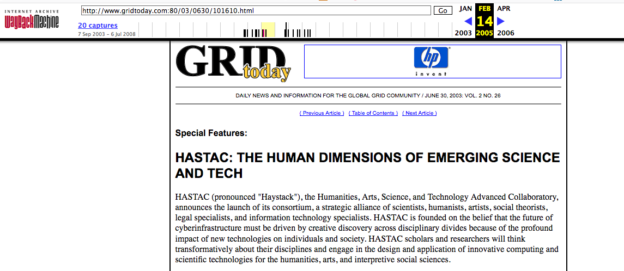DAILY NEWS AND INFORMATION FOR THE GLOBAL GRID COMMUNITY / JUNE 30, 2003: VOL. 2 NO. 26
Last week, I worked with two of HASTAC’s earliest developers, Casey Alt and Zach Pogue, and we were able to excavate some early HASTAC online resources that had been lost for a decade or so. This is a press release in the journal Grid Today about an early conference of some 55 scholars held at the University of California Humanities Research Institute on June 30, 2003. HASTAC was conceived the previous year, 2002, and we began meeting in smaller groups to plan this first interdisciplinary meeting together. (Keep in mind that MySpace was incorporated in 2003, Facebook in 2004).
***
Special Features:
HASTAC: THE HUMAN DIMENSIONS OF EMERGING SCIENCE AND TECH
HASTAC (pronounced “Haystack”), the Humanities, Arts, Science, and Technology Advanced Collaboratory, announces the launch of its consortium, a strategic alliance of scientists, humanists, artists, social theorists, legal specialists, and information technology specialists. HASTAC is founded on the belief that the future of cyberinfrastructure must be driven by creative discovery across disciplinary divides because of the profound impact of new technologies on individuals and society. HASTAC scholars and researchers will think transformatively about their disciplines and engage in the design and application of innovative computing and scientific technologies for the humanities, arts, and interpretive social sciences.
More than 55 scholars, practitioners, and industry representatives participated in the first meeting of the group at the University of California Humanities Research Institute (UCHRI), UC Irvine, on June 5-6, 2003. The resulting action plan calls for research, development, assessment, and application of emerging science and technology solutions. HASTAC representatives are participating in this week’s Global Grid Forum in Seattle, Washington, to discuss strategic alliances within the Grid community and take part in the development of the Global Grid Forum Humanities and Social Science Grid Research Group.
Topics for the June meeting at UC Irvine included collaboration in high-performance computing, biotechnologies, digital libraries, multimedia, archiving and search technologies, interoperable standards, and systems for virtual communications environments such as visualization caves. Issues of transformation, animation, preservation, and conservation came to the forefront along with the group’s vision to create, implement, distribute, and analyze new knowledge and discovery spaces.
“The humanities, arts, and social sciences have a very important role at the conceptual, research, and development stage of today’s science and technology discovery,” said David Theo Goldberg, director of UCHRI. Bringing together the expertise and experience found within HASTAC is critical to the future development of science and technology, and to the engagement of a much broader community.
Dan Reed, the director of the National Center for Supercomputing Applications, and Fran Berman, the director of the San Diego Supercomputer Center, both have noted the importance of including the humanities, arts, and social sciences in their centers high-performance computing research, and sent representatives to participate in the June meeting.
The founding HASTAC members include the University of California Humanities Research Institute; Duke University’s John Hope Franklin Center and Humanities Institute, Maryland Institute for Technology and the Humanities(MITH); Stanford Humanities Lab; Virginia Institute for Advanced Technology in the Humanities; San Diego Supercomputer Center at the University of California, San Diego; National Center for Supercomputing Applications at the University of Illinois; Minority Serving Institutions High-performance Computing Working Group; Creative Commons (an advocacy group supporting flexible intellectual property licensing applications); California Digital Library; and several other major digital archiving and exhibition centers, along with groups with overlapping concerns such as the Coalition for Networked Information, the National Initiative for a Networked Cultural Heritage, and industry partners.
The group is developing a white paper for the National Science Foundation’s cyberinfrastructure initiative. Upcoming HASTAC meetings will be held at the University of Illinois, Duke University, the University of Maryland and Stanford University. HASTAC welcomes the participation from a broad community of individuals and organizations with interests in the interface between science, technology, humanities, arts, and social sciences.
